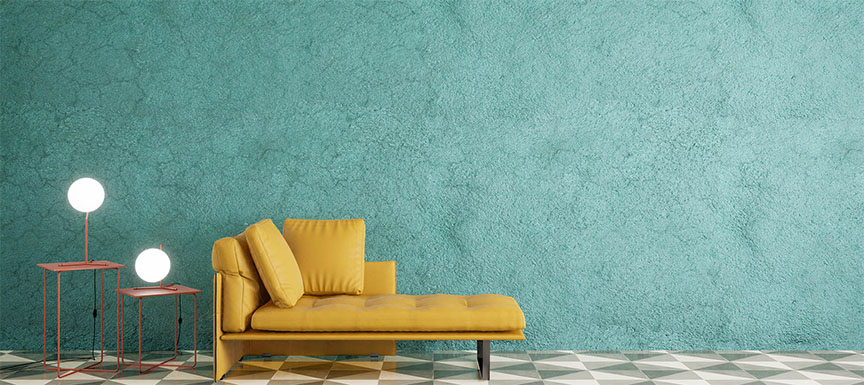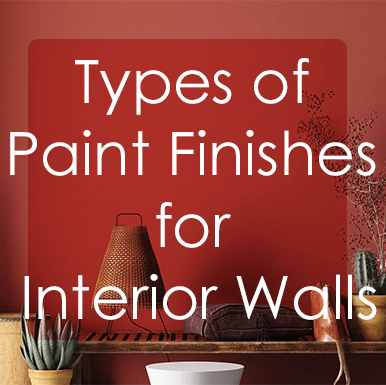Once you have selected the perfect colour for a room, a crucial decision remains the choice of finish. There are numerous types of paint finishes for interior walls. Even within a single colour, the variety is abundant, leading to several inquiries that require your attention.
To aid you in selecting the appropriate interior paint finishes for your interior home painting, here are the various uses and advantages of popular types of interior paint finishes.
The Chemistry of the Paint Finish Creates Different Types
The chemistry of paint plays a crucial role in determining its level of glossiness. High-gloss paints contain a higher concentration of resins and less pigment, resulting in a shinier finish. Conversely, flat paints have a higher pigment-to-resin ratio, leading to a less glossy appearance. This distinction explains why applying multiple coats is often necessary when using high-gloss paints, while a single coat of flat paint can provide sufficient coverage.
Both latex and oil-based paints are available in different paint finishes. However, for most individuals, latex paints are often considered the preferable option due to their advantages in terms of cleanup and fumes compared to oil-based paints.

Latex paints are water-based and can be easily cleaned using soap and water, simplifying the post-painting process. On the other hand, oil-based paints require solvents like mineral spirits for cleanup, which can be more time-consuming and potentially hazardous.
Also, latex paints generally have lower fumes or volatile organic compounds (VOC) levels than oil-based paints. This makes latex paints a more environmentally friendly and healthier choice, especially for indoor applications where proper ventilation might be limited.
Considering these factors, most people often prefer latex paints, as they offer easier cleanup and lower fumes than oil-based paints.

Different Types of Paint Finishes
Each paint finish we discuss has unique advantages and is used for different interior walls and applications.
Flat Paint Finishes for Interiors
Known as either “flat” or “wall paint,” this paint finish has an utterly matte surface devoid of shine. The texture of the surface may have a slightly chalky feel to it. Typically, this finish is applied to interior walls and ceilings. It is advantageous when aiming to conceal minor wall imperfections such as bumps, cracks, or flaws that a glossier finish might accentuate.
Although certain flat paints are now advertised as washable, touching up scratches or marks is often more practical by applying an additional coat of paint. It is advisable to have some extra paint on hand after completing the painting job for this purpose.

Flat Enamel or Matte Paint Finish
Flat enamel is a type of paint that offers a durable, flat, and matte finish. Its unique chemical composition allows it to form a thin protective film as it dries. This makes it a suitable option for areas like powder rooms or guest bedrooms, where occasional cleaning may be required. Certain manufacturers even label this type of paint as “matte” to differentiate it from their standard flat-finish paints.

Eggshell Paint Finishes for Interior Walls
An eggshell paint finish can be visualized as having a very low sheen, similar to the texture of an actual eggshell.
It offers a subtle hint of gloss, making it well-suited for most walls.
Compared to flat or flat enamel finishes, eggshell finishes have better durability when it comes to cleaning.
This makes them an excellent option for homes with children, as they balance washability and the ability to conceal flaws.
The popularity of eggshell finishes for wall applications stems from their ability to withstand cleaning while offering the advantage of camouflaging imperfections.

Satin Interior Paint Finish
Satin interior paint finish exhibits a smooth and velvety appearance, featuring a slightly higher gloss than eggshell finishes. While it is commonly used for windows, doors, trim, and ceilings, it can also serve as wall paint.
The satin interior paint finish is especially well-suited for areas that experience high traffic, such as kids’ rooms, kitchens, and bathrooms. Its formulation is designed to withstand cleaning and light scrubbing, making it a durable choice for surfaces that require regular maintenance.

Semi-gloss Paint Finish for Interiors
Sem-igloss interior paint finish is primarily applied on doors, trim, and cabinets, especially in kitchens and bathrooms.
It offers the convenience of easy cleaning while providing a pleasing and subtle shine without being overly flashy.
However, ensuring the walls are adequately prepared and smooth before applying semigloss paint is crucial.
This is because any imperfections or inadequately prepared surfaces can become more apparent when illuminated by the sheen of semigloss paint. Paying attention to surface preparation is essential to achieve satisfactory results with semigloss finishes.

High-Gloss Interior Paint Finish
High-gloss interior paint finishes possessing an almost mirror-like quality, as their shiny finish closely resembles the appearance of enamel or plastic.
While less commonly utilized in home interiors, this finish is gaining popularity for creating a striking visual effect on cabinets, trim, and furniture, particularly in formal and contemporary settings.
It’s important to note that high-gloss finishes tend to accentuate surface imperfections; thus, meticulous preparation is crucial before painting with high-gloss paints. Ensuring a smooth and flawless surface is essential to achieve optimal results with this finish.

Factors You Need To Consider Before Choosing Your Interior Paint Finish
When choosing paint finishes for interiors, it’s essential to think about your individual needs and design preferences. Here are some factors to consider:
- Durability: Evaluate the wear and tear the painted surface will endure. High-traffic areas might benefit from durable finishes that can withstand cleaning and scrubbing. For a rustic or vintage look, consider flat paint. However, if durability is a concern, flat enamel can be used for trim, while eggshell suits walls.
- Appearance: Consider the desired look and aesthetic of the space. Different finishes offer varying sheen levels, ranging from matte to high gloss. For a high-gloss style, rather than using it throughout the entire room, use it sparingly in select locations such as doors, trim, or an accent wall. A room with excessive glossy paint can sometimes feel cold and unwelcoming.
- Concealment: Evaluate whether you need a finish to help hide imperfections like bumps or cracks on the walls. Flat or eggshell finishes effectively minimize the visibility of flaws, making them suitable for rustic styles or spaces with a vintage look.
- Cleaning and Maintenance: Determine the cleaning requirements of the painted surfaces. Some finishes are easier to clean and maintain than others, which is particularly important in areas prone to spills, stains, or frequent cleaning.
- Purpose of the Surface: Consider the function of the painted surface. Different finishes may be more suitable for specific areas. Using a glossier finish for ceilings can help reflect light in the space. Ensure to use high-quality paint that will wear well and avoid cracking. Remember that glossier finishes will make any blemishes more noticeable, and touching up ceilings can be challenging.
- Personal Preferences: Ultimately, your taste and preferences should guide your decision. Choose interior paint finishes that align with your style and vision for the space, whether rustic, high-gloss or any other desired aesthetic.

FAQs for Interior Paint Finishes
Q: Can I use different paint finishes in the same room?
A: You can use different interior paint finishes in the same room to create visual interest or highlight specific areas. For example, you might use a flat finish for most walls and a semi-gloss finish for doors, trims, or accent walls. Ensure the finishes complement each other and contribute to the desired overall look.
Q: Do paint finishes affect the colour of the paint?
A: Yes, different finishes can slightly alter the appearance of the paint colour. Glossier finishes reflect more light, making colours appear brighter and more saturated. On the other hand, flat or matte finishes absorb more light and may make colours look slightly darker or less vibrant.
Q: Can I apply a different finish over an existing painted surface?
A: In most cases, you can apply a different finish over an existing painted surface. However, it’s essential to properly clean and prepare the surface before applying the new paint to ensure proper adhesion. It’s recommended to consult the paint manufacturer’s guidelines and consider sanding or priming if necessary.
Q: How does the sheen level of a paint finish affect the appearance of a room?
A: The sheen level of a paint finish can significantly impact a room’s overall look and feel. Higher sheen levels, such as gloss or semigloss, create a more reflective surface, making a room feel brighter and more spacious. Like flat or eggshell, lower sheen levels provide a more subtle, understated appearance.
Q: Are there any specific considerations for painting ceilings regarding paint finishes?
A: When painting ceilings, it’s common to use flat or matte finishes. These finishes help to minimize the appearance of imperfections and provide a smooth, uniform look. Since ceilings typically receive less direct light and have fewer touchpoints, the lack of shine is less noticeable.

